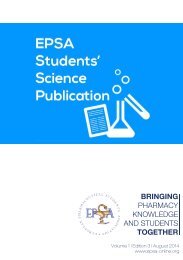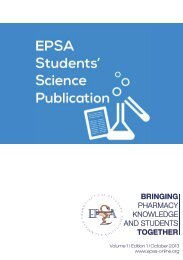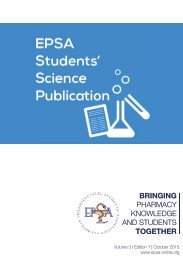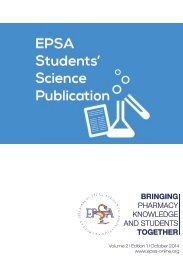essp02
You also want an ePaper? Increase the reach of your titles
YUMPU automatically turns print PDFs into web optimized ePapers that Google loves.
Bringing<br />
pharmacy<br />
knowledge<br />
and students<br />
together<br />
Volume 1 | Edition 2 | April 2014<br />
www.epsa-online.org
EPSA Students' Science Publication<br />
Dear friends,<br />
INTRODUCTION<br />
Not long ago, the Education and Public Relations departments presented<br />
the first edition of the EPSA Students’ Science Publication (ESSP) during the<br />
Autumn Assembly held in Valencia (Spain). The response, since then, has been<br />
very good. Students from across Europe have contacted us and expressed<br />
interest in sharing their research with others through the publication. It is our<br />
great pleasure to present you with the second edition of the ESSP!<br />
Since the last edition, some modifications to the publication have been<br />
made. A stepping stone was our partnership with the European Federation<br />
for Pharmaceutical Sciences (EUFEPS). They have carefully reviewed the<br />
abstracts and given feedback to the students. Their role is vital in ensuring that<br />
this publication consists of good quality and well-written abstracts.<br />
For this edition, we have tried to include a broad spectrum of topics. From<br />
pharmacy practice and pharmaceutical sciences, you can read about:<br />
services provided by community pharmacies, patent law, modification of the<br />
phenothiazine structure, breast cancer metastasis, and polyplexes as a form<br />
of delivery system.<br />
Hopefully you will find this interesting and inspiring for your future research. In<br />
which case, we would like to know all about your project for our next edition<br />
in July.<br />
Once again, a big thanks for all the authors and the EUFEPS for their hard<br />
work. Good luck for your studies, we hope to hear from you soon!<br />
Yours in EPSA,<br />
Rebwar Saleh, Science Coordinator 2013-2014<br />
Maria Pace, Publications Coordinator 2013-2014<br />
Svenja Laarhuis, Design Coordinator 2013-2014<br />
2
Table of content<br />
Volume 1 | Edition 2 | April 2014<br />
What factors may influence success of Community Pharmacy<br />
Stop Smoking Services? K. Mortensen, M. Kinnear, A Muir..... 4<br />
Q&A of the authors ......................................................................... 5<br />
The propargyl dericatives of quinobenzo- and<br />
quinonaphthothiazines. M. Małowska, K. Maciusiak, M. Jeleń,<br />
K. Pluta, B. Morak-Młodawska, K. Suwińska............................ 6<br />
Q&A of the authors ......................................................................... 7<br />
Crosstalk between integrin-beta1 and TGF-beta signalling in<br />
breast cancer cells. P. Akhavan................................................. 8<br />
Q&A of the authors ......................................................................... 9<br />
Characterization of nanosystems - polyplexes - for the specific<br />
delivery of siRNA targeting HDAC7. D. Barreira ..................... 10<br />
Q&A of the authors .................................................................. 11<br />
EUFEPS information ..................................................................... 13<br />
3
EPSA Students' Science Publication<br />
What factors may influence success<br />
of Community Pharmacy Stop Smoking<br />
Services?<br />
Mortensen K, Kinnear M, Muir, A<br />
NHS Lothian pharmacy service, Western General Hospital, Edinburgh, United Kingdom and<br />
Universities of Tromso, Norway and Strathclyde, Glasgow, United Kingdom<br />
Background and objective: To obtain an understanding of the factors<br />
which may impact on the varying success rates of NHS Community Pharmacy<br />
Stop Smoking Services.<br />
Setting and method: A questionnaire survey of 182 pharmacies and a<br />
national database of success rates and client demographics within one health<br />
board area were used to identify factors.<br />
Main outcome measures: Questionnaire parameters included client<br />
recruitment methods; staff training; number, type and continuity of staff; use<br />
of consultation room; approach used; use of appointments; use of carbon<br />
monoxide monitoring and perceived outcomes from repeated quit attempts.<br />
Database parameters included gender, age and employment status. Arbitrary<br />
pharmacy categories based on their success rates were used to identify<br />
potential predictors of success.<br />
Results: During 2012, a median (interquartile range (IQR)) of 19 (6 – 45) quit<br />
attempts per pharmacy was recorded and the IQR for quit rates (self-reported<br />
at 4 weeks) was 25.8% to 55.1%. Questionnaire responses (n = 81), suggested<br />
the consulting room was used commonly for initial consultations but less<br />
frequently for follow-up consultations. Not all pharmacy staff accessed the NHS<br />
smoking cessation training, some utilised sponsored training and employment<br />
training, some had only one-off training. A higher proportion (p < 0.001) of<br />
responders with a success rate ≥ 41% and with client quit attempts ≥ 10 had<br />
clients over 45 years of age compared to responders with a success rate < 41%<br />
and with client quit attempts ≥ 10. Using the same arbitrary groups there were<br />
differences in the proportions of males and females (p = 0.045) and employed<br />
clients and non-employed clients (p < 0.001) having a successful quit attempt.<br />
Responses did not suggest other potentially influencing factors on success<br />
rates. Respondents requested to receive feedback on their success rates.<br />
Conclusions: Gender, age, employment status of clients and use of the<br />
consultation room in community pharmacies are potential factors to test<br />
for association with successful smoking cessation outcomes. Feedback of<br />
success rates may motivate pharmacies. Defining levels of competence to<br />
deliver the service may inform training needs and improve consistency in<br />
standard of service delivery.<br />
4
Q&A of the authors<br />
General information about Mr Kristian Mortensen<br />
Age: 26<br />
City/country: Tromso, Norway<br />
E-mail address: Kristian_mm@hotmail.com<br />
University: University of Strathclyde.<br />
Volume 1 | Edition 2 | April 2014<br />
Why did you select this topic for your research?<br />
I developed a great interest for clinical pharmacy<br />
throughout my years as a pharmacy student, and Scotland<br />
is among the leading nations in clinical pharmacy.<br />
Therefore, I decided to complete my master's thesis in Scotland. I also chose<br />
Scotland to meet new people and learn about different customs and culture<br />
to further develop myself both professionally and personally. As for the topic,<br />
smoking cessation services, it was assigned to me. At first, I thought smoking<br />
cessation sounded really dull and uninteresting, but as I got deeper into the<br />
subject, I found I had developed a true passion for it. The complexity of quitting<br />
smoking successfully, is truly fascinating.<br />
How do you feel you have coped with the challenges that research can bring?<br />
Very good question. Before starting my thesis, I did not know that there were<br />
so many challenges with research. As pharmacists, we have a tendency to<br />
want everything to be perfect, but with research there are many bumps in<br />
the road that you cannot anticipate. Throughout the project period, I often<br />
gave myself a hard time, thinking that I could have done things better. But my<br />
supervisor always calmed me down by reminding me that a master's thesis is<br />
a learning process. The learning curve has been incredibly steep!<br />
What personal skills did you develop as a researcher during your research<br />
period?<br />
I have developed a lot more trust in myself with regards to decision making,<br />
and discussing academic and professional matters with superiors and other<br />
medical professionals. As pharmacists, we encounter quite a few 'know-it-all'<br />
physicians; I think the skills I have learned during my time on the project will<br />
be really helpful when it comes to discussing patient-orientated matters with<br />
these professionals.<br />
Anything else you want to share with the students in Europe? recommendations?<br />
To students working on similar projects: do not give yourself a hard time if<br />
everything does not go exactly as planned. Prepare, adapt and improvise!<br />
5
EPSA Students' Science Publication<br />
THE PROPARGYL DERIVATIVES OF<br />
QUINOBENZO- AND QUINONAPHTHOTHIAZINES<br />
M. Małowska 1 , K. Maciusiak 1 , M. Jeleń 1 , K. Pluta 1 , B. Morak-Młodawska 1 , K. Suwińska 2<br />
Students Scientific Group and Department of Organic Chemistry, The Medical University of<br />
Silesia 1 ; Institute of Physical Chemistry of the Polish Academy of Sciences, Poland 2<br />
Classical tricyclic phenothiazines, representing the dibenzo-1,4-thiazine ring<br />
system, attract attention because of their significant biological activities and<br />
interesting chemical features. Those with aminoalkyl substituents at the nitrogen<br />
atom in position 10 are valuable drugs exhibiting neuroleptic, antihistaminic,<br />
antitussive and antiemetic activities. Recently the phenothiazine structure has<br />
been modified by introduction of new substituents and by substitution of the<br />
benzene rings with homoaromatic and heteroaromatic rings. The substitution<br />
with an azine ring leads to azaphenothiazines. Such structure modifications<br />
changed type of biological properties to show very promising anticancer,<br />
antibacterial, antifungal, anti-inflammatory activities, reversal of multidrug<br />
resistance and potential benefit in treatment of Alzheimer’s, Creutzfeldt-<br />
Jakob’s and AIDS-associated diseases.<br />
The aim of this study was to elaborate the synthesis of new type of<br />
tetra- and pentacyclic azaphenothiazines, quinobenzothiazines and<br />
quinonaphthothiazines, possessing the quinoline and naphthalene rings<br />
instead of the benzene rings.<br />
The synthesis of those azaphenothiazines was based on the reactions<br />
of diquinodithiin and diquinolinyl disulfide with substituted anilines,<br />
and naphthylamines. The obtained NH-quinobenzothiazines and<br />
quinonaphthothiazines were transformed into derivatives containing a<br />
pharmacophoric propargyl substituent in the reaction with propargyl bromide.<br />
As the synthesis can proceed through the Smiles rearrangement, the<br />
crucial problem was the proper identification of the product structures. The<br />
identification of the product structures was based on the spectroscopic NMR<br />
(1H, 13C, 2D experiments), MS and X-ray analysis of their derivatives. The<br />
analysis excluded the rearrangement products.<br />
Most compounds exhibited significant activities as glycosylphosphatidylinositol<br />
phospholipase D inhibitor, anaphylatoxin receptor antagonist, antiparkinsonian<br />
and muscular dystrophy treatment in silico screening. The new azaphenothiazines<br />
will be tested for their anticancer and antioxidant activities.<br />
In conclusion, the efficient synthesis of new azaphenothiazines containing the<br />
quinoline and naphthalene moieties was elaborated.<br />
References: K. Pluta, B. Morak-Młodawska, M. Jeleń, Eur. J. Med. Chem., 46, (2011) 3179, M.<br />
Jeleń, K. Pluta, Heterocycles, 78 (2009) 2325, PASS-http//www.pharmaexpert.ru/PASSOnline/<br />
index.php.<br />
6
Q&A of the authors<br />
General information about Ms Monika Malowska<br />
City and Country: Katowice, Poland<br />
Year of Study: 5th.<br />
E-mail: monika.malowskaa@gmail.com<br />
Volume 1 | Edition 2 | April 2014<br />
Why did you select this topic for your research?<br />
I have always been interested in the preparation of<br />
medicines. During my studies I have found out how the<br />
formation and identification of new compound is difficult.<br />
Anyone who takes pills, expects biological effect. The most<br />
often active substance in drugs is organic compound. Phenothiazines belong<br />
to the oldest, synthetic, antipsychotic drugs. The structural modifications<br />
to phenothiazines change the biological properties, for example: anticancer,<br />
antibacterial, antifungal, anti-inflammatory activities, reversal of multidrug<br />
resistance and potential benefit in treatment of Alzheimer’s, Creutzfeldt-<br />
Jakob’s and AIDS-associated diseases. The relationship between chemical<br />
structure and biological activity is very interesting.<br />
How do you feel you have coped with the challenges that research can bring?<br />
I took part in real scientific research and chemical synthesis based on<br />
the theoretical and practical knowledge. I synthesized new derivatives of<br />
phenothiazines which were examined for their anticancer and antioxidant<br />
activity. I hope that the obtained compounds will be a medicine of the future.<br />
What personal skills did you develop as a researcher during your research<br />
period?<br />
I found out that synthesis of new compounds require a lot of time and patience.<br />
Chemical synthesis leads to the formation of variety products; that’s why the<br />
desired product is difficult to separate out. The new products’ structures<br />
were deduced using spectroscopic NMR analysis (1H, 13C, two-dimensional<br />
experiment), mass spectrometry and X-ray analysis. As a researcher I got<br />
to know new methods of product identification and how to synthesise new<br />
compounds.<br />
Anything else you want to share with the students in Europe? Recommendations?<br />
The aim of this study was to synthesize a new derivatives of phenothiazines,<br />
which exhibit other than neuroleptic activity. It was very valuable experience<br />
for me. I would like to encourage you to deepen your knowledge. Participate<br />
in the scientific group, student’s exchange or oral presentation may improve<br />
your ability. If you are reading this text I believe that you are on the right way<br />
to achieve it.<br />
7
EPSA Students' Science Publication<br />
Crosstalk between integrin-beta1 and<br />
TGF-beta signalling in breast cancer<br />
cells<br />
Ms. Parand Akhavan<br />
University of Leiden, the department of toxicology at the Leiden Academic Centre for Drug<br />
Research (LACDR)<br />
As the incidence levels of breast cancer continues to increase, the<br />
development and discovery of novel treatments are an ongoing priority to<br />
researchers. Adhesion receptors of the integrin family allow cells to interact<br />
with their environment. These receptors play a crucial role in cell survival and<br />
growth which make integrins potential drug targets in oncology. Some integrin<br />
antagonists are currently tested in clinical trials. Our group has found that<br />
such strategies can decrease the tumour size but actually increase metastatic<br />
spreading of triple negative breast cancer cells. This involves the activation of<br />
the TGF-beta signalling network leading to a loss of the E-cadherin cell-cell<br />
adhesion receptor.<br />
In this research project the aim lies in further unravelling the relation between<br />
beta1-integrin, the TGF-beta/BMP pathway, and E-cadherin expression in the<br />
modulation of breast cancer metastasis. We do this using the triple negative<br />
human breast cancer cell lines: BT20, HCC 1806, 70, 1596 & MDA-MB-468.<br />
Effects of TGF-beta stimulation and beta1 integrin knockdown are analysed<br />
using qPCR and western blot. qPCR results show a difference in regulation of<br />
TGF-beta/BMP pathway factors between the BT20 and the HCC 1806 &MDA-<br />
MB-468 and their respective knockdowns. Further validation is needed to<br />
make an accurate distinction. In parallel, we investigate whether the changes<br />
observed in vitro can also be seen in vivo in the tumours generated with<br />
these cell lines in mice. Immunohistochemistry is used to detect differences<br />
in E-cadherin and components, such as pSMAD2, of the TGF-beta signalling<br />
pathway in tumours derived from wild type or beta-1-integrin knockdown<br />
breast cancer cells.<br />
Together, this study will further unravel how integrins control signalling<br />
pathways regulating cell migration and metastasis. This will shed light on the<br />
reasons why integrin antagonists can inhibit breast cancer growth but also<br />
cause enhanced metastatic spread.<br />
8
Q&A of the authors<br />
General information about Ms. Parand Akhavan<br />
Age: 22<br />
City and country: Leiden, The Netherlands<br />
Email address: parandakhavan@gmail.com<br />
University: University of Leiden<br />
Why did you select this topic for your research?<br />
It was partly a personal reason but also because the<br />
research into cancer and its metastasis is always ongoing.<br />
It is so amazing to see how, even if it is in vitro, cells<br />
change their behaviour.<br />
Volume 1 | Edition 2 | April 2014<br />
How do you feel you have coped with the challenges that research can bring?<br />
In the beginning it sometimes really drove me mad if something didn’t work for<br />
the 20th time or if the cells I work with didn’t grow or there weren’t enough to<br />
perform an experiment. Along the way you learn to let go of that and anticipate<br />
certain challenges. The thing that also changes is that you learn who to turn to<br />
for help.<br />
What personal skills did you develop as a researcher during your research<br />
period?<br />
I think the most important thing you learn in research is patience. In my case I<br />
am dependent on different factors which I can’t control such as cell growth. If<br />
the cells don’t have the confluency needed for an experiment you need to wait.<br />
Anything else you want to share with the students in Europe? Recommendations?<br />
Try to see every aspect of your studies. It can amaze you what you finally end<br />
up enjoying the most.<br />
9
EPSA Students' Science Publication<br />
CHARACTERIZATION OF NANOSYSTEMS -<br />
POLYPLEXES - FOR THE SPECIFIC DELIVERY OF<br />
siRNA TARGETING HDAC7<br />
Daniel António Esperança Faustino Monteiro Barreira.<br />
Faculdade de Farmácia, Universidade de Lisboa<br />
Cancer is one of the most deadly pathologies in the world; therefore, it is<br />
important to have as many and different approaches as possible when it comes<br />
to its treatment. As it is a complex and highly heterogeneous pathology, classic<br />
treatments are often lacking efficiency and are insufficient, which makes even<br />
more important the development of new strategies, such as gene targeting<br />
therapy.<br />
Concerning different delivery system-based approaches, there are both viral<br />
and non-viral vectors. The non-viral vectors, which are here under discussion,<br />
are resultant from the complexation of siRNA molecules with cationic polymers.<br />
Preliminary formulation studies have been performed using several polymers<br />
– C93, C122, C145, C172 and C173 - in which several tests were performed.<br />
These tests included determination of polyplexes capacity to release siRNA<br />
into the cytoplasm in the presence of heparin, polyplexes stability and diameter<br />
variation depending on pH modulation, and polyplexes capacity to protect<br />
siRNA from serum nuclease RNase A.<br />
Regarding the heparin destabilization, the developed polyplexes proved to<br />
effectively release siRNA in the presence of heparin, being the amount released<br />
dependent on the quantity of heparin used (1 UI being the minimum quantity to<br />
effectively promote the release of siRNA).<br />
About the pH, the polyplexes proved to be stable at pH values varying from<br />
7.5 to 5 (pH 6.0–6.5 in early endosomes to pH 4.5–5.5 in late endosomes and<br />
lysosomal compartment) and to have no significant variation in particle size<br />
diameter at lower pH values.<br />
Concerning the complexes resistance to RNase A, all proved to be resistant to<br />
this enzyme.<br />
The polymers used for siRNA complexation lead to complexes that have<br />
shown to have promising parameters being thus promising candidates for<br />
further in vitro studies, as cellular uptake and viability studies, assessment of<br />
topographical profiles and complexes’ biological effect by inferring their ability<br />
to reduce the level of the HDAC7 protein and thus inhibit its biological function.<br />
Keywords: Cancer therapies, Angiogenesis, Polyplexes, Heparin, HDAC7 and<br />
siRNA<br />
10
Q&A of the authors<br />
General information about Mr Daniel Barreira<br />
Age: 24 years old<br />
From: Lisboa, Portugal.<br />
daniel.espbarreira@gmail.com,<br />
Université de Liège (Belgium)<br />
Volume 1 | Edition 2 | April 2014<br />
Why did you select this topic for your research?<br />
Oncology is a hot topic in health sciences and a<br />
challenging area to any pharmacist or student interested<br />
in research. So, cancer - and particularly gene therapy<br />
applied to tumors - is a whole new world to explore, therefore I was curious to<br />
go deeper into that subject.<br />
How do you feel you have coped with the challenges that research can bring?<br />
As I was doing research in a foreign country first I had to adapt to different<br />
methodologies. After I found my comfort zone, I think I became up to the<br />
challenge and enthusiastic about knowing more and being able to self-instruct<br />
about the topic.<br />
What personal skills did you develop as a researcher during your research<br />
period?<br />
I think time management and perseverance are of the utmost importance. Also,<br />
it is important to find the motivation (be it in your research work or in other<br />
tasks) when the results don’t match what you expect or when the research<br />
work is going in a wrong/unexpected direction.<br />
Anything else you want to share with the students in Europe? Recommendations?<br />
I would really encourage any of you to try research work as it is one of the most<br />
rewarding experiences that I’ve had so far academically. Also, independent<br />
of the career path you choose you will develop some transitional skills to an<br />
upper level. Definitely try it!<br />
11
EPSA Students' Science Publication
Volume 1 | Edition 2 | April 2014<br />
The European Federation for<br />
Pharmaceutical Sciences (EUFEPS)<br />
The European Federation for Pharmaceutical Sciences is a voluntary<br />
association of pharmaceutical scientists, established in 1991 to advance<br />
research in the pharmaceutical sciences in Europe. This can be achieved by<br />
promoting cooperation between national, regional and European societies or<br />
associations which aim at the advancement of pharmaceutical sciences, and by<br />
promoting cooperation between and with other pharmaceutical organisations<br />
and between individual pharmaceutical scientists.<br />
The Mission<br />
EUFEPS exists to help to meet the challenges and seize the opportunities<br />
created by the consolidations occurring both within Europe and globally,<br />
driven on by a combination of rapid advances in science and technology,<br />
economic pressures, and by political will. Within this frame, EUFEPS’s role and<br />
contributions are amply expressed in its mission statement “EUFEPS serves<br />
and advances excellence in the pharmaceutical sciences and innovative drug<br />
research in Europe”. Spearheading a number of initiatives, EUFEPS works with<br />
its membership, throughout the nations of Europe.<br />
European Dimension<br />
EUFEPS is unique being the only pan-European organisation that represents,<br />
under one umbrella, all the pharmaceutical sciences and pharmaceutical<br />
scientists engaged in drug research and development, drug regulation and<br />
drug policy making. The existence of such an umbrella platform facilitates the<br />
highly innovative, integrative and interdisciplinary approaches that are essential<br />
if we, in Europe, are to deliver to our citizens safe, effective, economic and<br />
timely medicines. The ultimate benefits are an improving health, quality of life,<br />
and wealth of our continent.<br />
13
EPSA Students' Science Publication<br />
EUFEPS is recognised by the European Commission, as representing the<br />
integrative pharmaceutical sciences within Europe. EUEFPS is also recognised<br />
by the EMEA as a neutral scientific resource for independent opinions on draft<br />
regulatory guidelines, while EUFEPS works with other European organisations,<br />
such as EFPIA, to help identify and promote training to meet industrial needs.<br />
EUFEPS has the ambition to provide a forum for policy development in<br />
the pharmaceutical sciences, particularly in relations to the discovery and<br />
development of new drugs and their introduction into the market, but also as<br />
to medicines usage. This includes policies on and leadership development as<br />
to: research, education & training, profiling and regulatory affairs.<br />
In addition, EUFEPS plays an active and influential role also in the global arena.<br />
It is recognised by the USA FDA and it works actively with its sister organisation<br />
AAPS to develop co-sponsored meetings and workshops that run alternatively<br />
in Europe and the USA, and is developing links with Asian scientists. Through<br />
involvement with its Board of Pharmaceutical Sciences, EUFEPS is also<br />
working with FIP to advance the pharmaceutical sciences globally.<br />
14
Volume 1 | Edition 2 | April 2014<br />
Conferences and Workshops organised by<br />
EUFEPS:<br />
EUFEPS and BABP Network conference<br />
Date: May 6-7, 2014<br />
Place: Berlin, Germany<br />
EUFEPS Annual Meeting 2014: Medicines<br />
for the Future – System Approaches to<br />
shape Pharmaceutical Science<br />
Date: June 16-18, 2014<br />
Place: Uppsala, Sweden<br />
In addition to these events that is organised, EUFEPS also is<br />
listed as co-sponsors to several events during the year. For More<br />
information see: http://www.eufeps.org/conferences<br />
15









